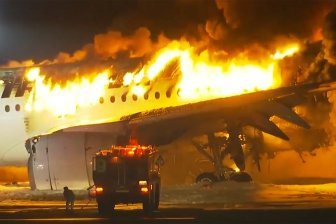Canada is ‘improving’ on earthquake preparedness, but more can still be done
 By Sean Previl Global News Posted January 3, 2024 7:00 am Updated January 2, 2024 8:13 pm
By Sean Previl Global News Posted January 3, 2024 7:00 am Updated January 2, 2024 8:13 pm  Japan earthquake death toll nears 50 as officials warn of aftershocks
Japan earthquake death toll nears 50 as officials warn of aftershocks Share
Share this item on Facebook facebook Share this item on Twitter twitter Send this page to someone via email email Share this item via WhatsApp whatsapp Share this item on Flipboard flipboard Share this item on Reddit redditWith improving building codes, education initiatives and an early-warning system to come later this year, Canadian seismologists and civil engineers say the country’s earthquake preparedness is “improving,” but there’s still work to be done.

“There are a lot of things that we can improve, we are improving,” David Lau, structural engineering professor at Carleton University, told Global News in an interview. “Researchers learn from how the infrastructure, the buildings, the bridges perform during the earthquake and (the) lesson will be learned how to improve our design standards for next time.”
The comments come a day after western Japan was hit by a series of powerful earthquakes on New Year’s Day, leaving at least 57 people dead and thousands of buildings, vehicles and boats damaged. Aftershocks continued to hit Ishikawa prefecture and nearby areas on Tuesday, following the magnitude-7.6 quake.
With the risk ever present, Natural Resources Canada seismologist Camille Brillon said the federal government is working to ensure not only that Canadians are prepared, but that infrastructure is, too.
Story continues below advertisementShe said on the infrastructure side, the country’s building code is updated every five years, taking into account new research to ensure new builds are built to these standards, but also to retrofit existing buildings to better stand up to structural issues, such as earthquakes.
“As earthquakes happen, the Canadian hazard model improves and that goes into the building code and that improves,” she told Global News.
 Canada releases national risk profile to help better prepare for climate disasters
Canada releases national risk profile to help better prepare for climate disasters Part of that improvement is based on the sharing of information from other countries as well, with Brillon noting that knowledge gained from how the ground shook in Japan, Chile and Mexico is used to improve Canada’s own standards.
Brillon notes officials are hoping to ensure future preparedness as well, with the planned launch of a national early-warning system expected to be rolled out later this year, which she said would put Canada “sort of ahead of the game.”
Story continues below advertisementSuch a system is utilized by more than 16 countries globally, according to UC Berkeley’s Seismology Lab, and once implemented in Canada would warn people there would be “strong shaking” set to occur and could provide seconds or “tens of seconds” of early warning, Brillon said. While it would help Canadians know to expect a possibly strong quake, it would also give industry and critical infrastructure the time to take action.
“(They) should also be using this information to open doors, shut off valves, stop drains, close tunnels, stuff like that,” she said, adding it would also give medical professionals time to stop intricate surgical procedures.
Emergency Preparedness Minister Harjit Sajjan’s office referred Global News to provincial governments, including B.C. and Quebec, for more information on local management, noting provincial and local governments remain the first responders.
Get the latest National news. Sent to your email, every day.In terms of federal response, however, the ministry said the government is constantly monitoring new and evolving threats across the country and has strong plans in place to ensure an “effective response” to all hazards.
Sajjan’s office said the primary way risk is managed is through building codes, as Brillon noted, ensuring new structures protect occupants from potential ground shaking. It also noted the 2023 federal budget announced various initiatives to support Canadians in preparing for and recovering from disasters, including first steps towards developing insurance solutions for earthquakes.
Canada doesn't 'do recovery very well': IBC
While earthquakes are much rarer in Canada, they can happen from coast to coast, though places like B.C. and Yukon territory, Ontario and Quebec are some of the more active areas.
Story continues below advertisementQuebec, for example, has two seismic zones, with the Insurance Board of Canada (IBC) reporting a major quake in the region could result in up to $61 billion in losses. The Charlevoix Seismic Zone in the province’s northeastern region has had at least five earthquakes measuring in magnitudes of more than 6.0 in the past four centuries.
It’s B.C., however, that is at the highest risk in the country, with the potential for the province to see a magnitude-9.0 quake. By comparison, it was a 9.0 earthquake that hit Japan in 2011, triggering a 15-metre tsunami, disabling the power supply and cooling systems at the Fukushima nuclear power plant. The IBC said in the first draft of Canada’s natural disaster risk assessment, released last May, that damages to B.C. from such a quake could top $75 billion.
IBC vice-president of climate change and federal issues Craig Stewart told Global News that Canada’s insurance industry is built to withstand “sizable catastrophes,” but a significant event such as a magnitude-9.0 would require assistance from Ottawa.
He said based on modelling, a number of credit unions and insurance companies would potentially be at risk, and the entire industry would need stabilizing.
 3.9-magnitude Banff earthquake ‘not unusual’ for Rocky Mountain region: seismologist
3.9-magnitude Banff earthquake ‘not unusual’ for Rocky Mountain region: seismologist “We’ve seen a shift in the earthquake insurance market, particularly in British Columbia, where the cost of insurance is much higher than it was a few years ago,” Stewart said. “So that means that not only are insurers exposed, but more consumers are exposed because they’re not covered to the same extent as they were previous.”
Story continues below advertisementStewart said modelling released in 2020 from the government of Canada found the risk of a significant geological event had risen from just five years prior. The report noted an increased hazard of about 50 per cent, particularly in places like eastern Ontario and southern Quebec.
It may not help, either, that the risk report from Ottawa found uninsured or under-insured Canadians are the most at risk with it most pronounced in Quebec, where fewer than five per cent of households have earthquake insurance. In B.C., meanwhile, the number sits between 40 to 70 per cent of residential properties — though it notes deductibles and terms may limit coverage.
Stewart said one big issue facing Canada is that the country doesn’t “do recovery very well,” taking sometimes a more reactionary stance and responding to disasters rather than anticipating they will happen and having recovery plans in place.
He pointed to countries like Japan, which has a formal arrangement between insurers and the federal government for when earthquakes hit. Such an arrangement is under discussion starting with a national flood insurance plan, with the hope to include earthquakes into the framework eventually.
This idea would see consumers still covered by insurance companies, but the federal government would have an arrangement to provide a financial backstop where needed when Canadians face earthquake fallout.
Drop, cover and hold on: Preparing for a quake
Even though insurance can help with financial costs, Brillon cautions people need to be aware not only about where they live in terms of risk, but where they’re going if they travel and the hazards they can face.
Story continues below advertisementAmong the things people can do is secure items around the house, with Natural Resource Canada noting this can include adding a steel or plywood frame to a garage door or window openings and securing them with anchor bolts, as well as fixing bookshelves to your walls.
- Here are the tax changes that will affect your pocketbook in 2024
- ‘Demoralizing’: Rent cap rises to 5% in N.S., putting tenants under further strain
- Saskatchewan carbon price halt shouldn’t affect rebates, minister says
- N.S. family moves into new home with same ‘blueprint’ following destructive wildfire
According to Great ShakeOut earthquake drills, held annually by Earthquake Preparedness B.C., there are three important steps to take when an earthquake is happening. First, drop to the ground on your hands and knees, which protects you from being knocked down and reduces your chances to being hit by falling or flying objects. A person should then take cover under a sturdy table or desk, but if such a shelter isn’t nearby, crawl to an interior wall, and stay on your knees while bent over to protect vital organs.
Finally, hold on until the shaking stops. If you’re under a shelter, hold on to it with one hand but be ready to move with the shelter if it shifts, while those without one should hold on to your head and neck with both hands.
Brillon says the most important thing to do, however, is to have an emergency kit and a plan. The kit should include non-perishable food, water, and other items like a first-aid kit, battery or crank-powered radio and flashlight, and personal toiletries. This should last you for at least 48 hours, but she said to also plan for beyond that, because it is possible you could be without power or safe water in certain hours for longer.
Story continues below advertisementIn addition, families should plan for what to do if they’re not together at home — like if the event happens while some members at school or work — and ensure they’re prepared in whatever situation they’re in.
“You really have to be prepared to be on your own for a couple of weeks,” Brillon said.
— with files from Global News’ Neetu Garcha and The Canadian Press

 Japan Airlines plane bursts into flames after collision on Tokyo runway
Japan Airlines plane bursts into flames after collision on Tokyo runway  Canada’s top CEOs have already made more than average worker will in 2024
Canada’s top CEOs have already made more than average worker will in 2024 
 相关文章
相关文章



 精彩导读
精彩导读



 热门资讯
热门资讯 关注我们
关注我们
